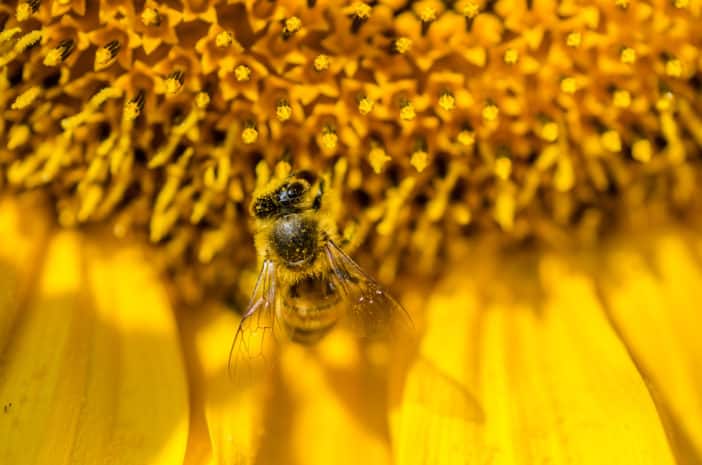Bee venom (BV)

As useful as our bees are, a sting is usually very painful and unpleasant. The swelling, pain and itching are caused by the bee venom (BV), which the bee injects into its “opponent” via the venom sting. In the worst case, bee venom can even trigger life-threatening allergic reactions: One more reason to avoid the industrious insects whenever possible. Surprisingly, however, bee venom is also a valuable active ingredient in medicine and cosmetics. Why this is so is mainly due to the composition of the bee’s apitoxin.
The composition of bee venom (BV)
Bee venom (BV) is first of all relatively acidic, because the pH value is between 4.5 and 5.5. It has a clear to yellowish color and causes a local inflammation at the sting site. Incidentally, in medical terms bee venom (BV) is called apitoxin, which is derived from the Latin term “apis” (bee) and the ancient Greek term “toxikón” (poison). Apitoxin consists of various proteins and molecules. With a share of 50 percent, melittin forms the main component. Melittin is a cationic polypeptide composed of more than 20 amino acids and is the most important allergen in bee venom. Other ingredients of apitoxin include phospholipase A2, an enzyme that is present in about twelve percent and has both anticoagulant and circulatory effects, the neurotoxin aptamine (about two percent, causes cortisol production in the adrenal cortex to increase), and hyaluronidase (also two percent), a substance that dilates blood vessels and makes them more permeable so that inflammation can spread more easily. Molecules in bee venom include histamine (triggers the typical itching), the neurotransmitter dopamine (popularly known as the “happiness hormone”), and the neurotransmitter norepinephrine, which acts as a stress hormone similar to adrenaline. Among other things, norepinephrine is known as an emergency drug in intensive care medicine, as the substance provides valuable services in septic, cardiogenic or anaphylactic shock.
In total, apitoxin contains over 30 different components, some of which cannot be produced synthetically at all. This means that bee venom (BV) is a cocktail of active ingredients that is absolutely unique in this composition. For allergy sufferers, however, bee venom poses considerable risks due to the interaction of melittin as the main allergy trigger and the other components of apitoxin. Typical symptoms of an allergy to bee venom and melittin are swellings on and in the throat, a strong reddening of the skin and shortness of breath, which can become life-threatening.
The bee produces apitoxin in its abdomen and stores it in the venom sac. Each sting releases about 0.1 milligram of bee venom (BV). When stung, the stinger and venom blister become lodged in the skin: For the bee, this injury is fatal.
Melittin and its medicinal effect
Long ago, Paracelsus already stated that the toxicity of a substance depends on its dosage. He even went one step further and found out that the dosage determines whether the substance actually acts as a poison or as a medicine. This basic principle also applies to bee venom and melittin. When the bee stings, the area swells, becomes red, painful, and itchy. This happens, among other things, because the apitoxin promotes blood circulation. And it is precisely this aspect that the fields of medicine and cosmetics take advantage of.
If the bee injects its venom into healthy and non-inflamed tissue, the typical symptoms such as redness, swelling, pain and overheating occur. However, if a doctor or therapist triggers a targeted local inflammation with bee venom (BV), increased metabolic activity occurs in the targeted area. The warmth loosens the tissues and relaxes the muscles, stimulating the elimination of cellular toxins and waste products.
Studies have also shown that melittin has an anti-inflammatory effect in tissue that is already inflamed. The substance stimulates the body’s own cortisol secretion, and since cortisol inhibits excessive immune activity, the inflammation consequently decreases.
In Chinese medicine, it has been known for a long time that massaging or applying the bee venom into deeper tissue layers can be a healing stimulus. The venom is therefore also traditionally used in the context of acupressure treatments and Tuina massages, but also for diseases of the musculoskeletal system such as muscular overload, arthritis, and arthrosis. Also, nerve pain in sciatica and zoster neuralgia can be alleviated or even cured by venom. However, before treatment, it must be carefully checked whether the patient is allergic to melittin. If hypersensitivity is present, desensitization can be performed. In preparations against rheumatism, lumbago, sports injuries as well as cold injuries bee venom is already successfully used today. This form of treatment is called apitherapy (medical use of bee products). And also, in homeopathy bee venom (BV) in diluted or also potentized form is a fixed quantity and known under the name Apisinium.
Apitoxin in cosmetics
When bee venom hits the skin, it reacts with defense mechanisms: blood circulation is stimulated and the skin boosts elastin and collagen production. Basically, this is an anti-aging effect, because after all, elastin and collagen are among the most important components of our skin. They are responsible for firmness and tissue strengthening. But the older we get, the more these two components lose productivity. The consequence, often perceived as unattractive, is that the skin becomes flabbier and exhibits significantly less elasticity. Apitoxin counteracts these natural signs of aging. It is now frequently used instead of Botox to smooth out small wrinkles and give the skin a more even appearance. The melittin contained in bee venom also performs an important cell-protective function against inflammatory stimuli and its effect is 100 times more anti-inflammatory than cortisone.
Successful examples of the use of apitoxin already abound. A cosmetic serum containing bee venom, for example, can trigger minimal micro-swelling of the skin that immediately makes wrinkles and lines less visible. Masks and creams with apitoxin have the same effect.
However, it is also true for cosmetic products that allergy sufferers should refrain from using them without sufficient desensitization. In case of doubt, it is advisable to consult a doctor before the first application.
Fact Sheet Apitoxin (BV)
INCI: Bee Venom
CAS number: 91261-16-4
Effect: protects the skin from external factors, reduces pores, anti-aging, wound healing, antibacterial and anti-inflammatory effects
Application: anti-aging skincare, botox alternative
Bee-friendly extraction of apitoxin
In order to produce cosmetic products with apitoxin, no insects have to give up their lives. A gentle method has already been developed to encourage the little nectar collectors to sting. For this purpose, specially constructed glass plates with a wafer-thin fleece covering are placed in front of a beehive. Fine metal threads are integrated into the glass plates, through which a (small) electric current flows. When a bee lands on a glass plate, it is provoked by the electrical impulse and stings. The apitoxin passes through the fleece onto the glass plate, where it can be removed. Due to the hard substrate, the bee’s stinger does not get stuck, so it can retract it and is neither killed nor injured.
More than just an alternative for Botox
Bee venom (BV) as a natural cosmetic active ingredient offers enormous potential. It is more than “just” a gentle alternative to Botox, but an excellent anti-aging agent for a wide range of applications. Especially for serums, face and eye creams as well as masks apitoxin is ideal. This is an anti-wrinkle treatment without any chemicals, where at most a slight tingling sensation is felt because the body reacts with an increased blood flow. People who do not suffer from an allergy to apitoxin can use such products without hesitation, but they are not suitable for allergy sufferers. Cosmacon will be happy to advise you about bee venom (BV) in cosmetics!
Sources:
Bee Products in Dermatology and Skin Care.; Molecules. 2020 Jan 28;25(3):556.
Bee Venom in Wound Healing.; Kurek-Górecka A, Komosinska-Vassev K, Rzepecka-Stojko A, Olczyk P. Molecules. 2020 Dec 31;26(1):148.
Effects of Emollient Containing Bee Venom on Atopic Dermatitis: A Double-Blinded, Randomized, Base-Controlled, Multicenter Study of 136 Patients.; You CE, Moon SH, Lee KH, Kim KH, Park CW, Seo SJ, Cho SH. Ann Dermatol. 2016 Oct;28(5):593-599.
Inhibitory effects of bee venom on Propionibacterium acnes-induced inflammatory skin disease in an animal model.; An HJ, Lee WR, Kim KH, Kim JY, Lee SJ, Han SM, Lee KG, Lee CK, Park KK.Int J Mol Med. 2014.
Effects of cosmetics containing purified honeybee (Apis mellifera L.) venom on acne vulgaris.; Han SM, Lee KG, Pak SC. J Integr Med. 2013 Sep;11(5):320-6.
